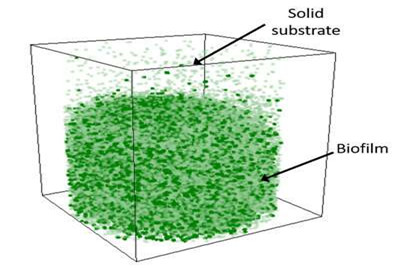
Biofilms are integral to Earth's ecology and the sustainability of life. Made up of microorganisms, biofilms play vital roles in recycling life's most essential elements. But a lack of versatile analytical tools has made it challenging to extract critical information about biofilm processes.
A new way to study biofilms
Now, EMSL scientist Zihua Zhu and colleagues have developed a way to study biofilms in their native state, making it possible to examine biofilm-substrate interfaces at the molecular level for the first time. Already, the team has learned that biofilms of the bacterium Shewanella oneidensis, and one of its mutants, can survive the introduction of chromium (VI), a known carcinogen widely used as an anti-corrosive agent. Using biofilms to clean chromium (VI)-contaminated waters could prove revolutionary in our efforts to remediate legacy industrial waste sites.
The tool that makes this possible is called in situ liquid secondary ion mass spectrometry (SIMS). Traditional SIMS techniques prevent researchers from studying aqueous systems because the presence of water vapor interferes with the vacuum, invalidating results. They are also considered "hard" methods in that they disrupt many molecular-level interactions that scientists are interested in studying. In situ liquid SIMS, however, is designed to bypass the problem of high vapor pressure.
How it's done
In situ liquid SIMS is used to investigate molecular structures in solution. By blasting a high-energy ion beam at the solution's surface, researchers can force eject a range of particles—from single atoms to molecular clusters. Scientists use a high-vacuum environment to isolate the ejected particles, some of which are ionized, from the bulk sample. The ionized particles are then introduced into a mass spectrometer and analyzed.
Because so many systems important to human life naturally occur in water-based environments, the development of in situ liquid SIMS extends current scientific boundaries by allowing scientists to study a host of systems, including those of aerosols, in their native state without disrupting key interactions.
Comparing in situ liquid SIMS to a molecular eye, Zhu says it allows scientists to examine molecules directly to see what is occurring at their level. The technique, first custom-developed in 2011, features the basic design of traditional SIMS with modifications for studying aqueous samples. One such adjustment is the use of a microfluidic interface. This involves the use of a thin silicon nitride layer placed between the sample (which flows through a tiny channel) and its environment, effectively quarantining the sample from contamination and from the high-vacuum surroundings of the SIMS instrument. The machine then uses a high-current ion beam to carefully drill a hole through the silicon nitride layer until the solution is exposed by a microscopic 2-μm-thick opening. Because the hole is so tiny, the surface tension of the sample minimizes the evaporation of water while still granting the SIMS beam access.
From cloud formation to the amount of particulate matter in the air, organic aerosols play a key role in atmospheric and climatic processes. Originating primarily from small organic molecules emitted by plants, understanding how they become larger, heavier components in secondary organic aerosols can help researchers produce better predictive models. With in situ liquid SIMS, researchers can perform molecular-level analysis of secondary aerosol nucleation, a process that occurs when chemical reactions create particles from gaseous primary aerosols.
Zhu and his team have already brought to light critical information about the initial nucleation of secondary aerosols—important information for evaluating the impact of aerosols on atmospheric processes.
Success comes from team effort
Zhu, along with PNNL researcher Xiao-Ying Yu and former PNNL staff member James Cowin, began in 2010 to focus more intensively on the development of in situ liquid SIMS. Their invention, initially conceived by Yu, was patented in 2013 and won an R&D 100 Award in 2014. To date, Zhu and his team have published 24 papers related to in situ liquid SIMS, with eight of those papers featured as covers in high-impact journals, including Analytical Chemistry, Analyst, and Journal of Physical Chemistry Letters.
Yu is currently the lead scientist on another project using in situ liquid SIMS to study the role of the air-liquid interface in secondary aerosol formation.
Zhu and his colleagues currently have three in situ liquid SIMS papers in revision and more in the works. They have no plans to stop anytime soon—the team's guiding purpose is to expand applications of in situ liquid SIMS and act as trailblazers of the technique.
"We've achieved a lot already, but my biggest wish is to have other scientists put the techniques we've developed to good use to tackle additional science questions," says Zhu.

